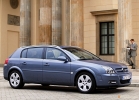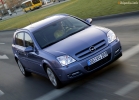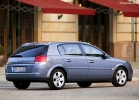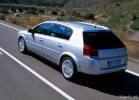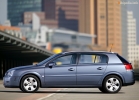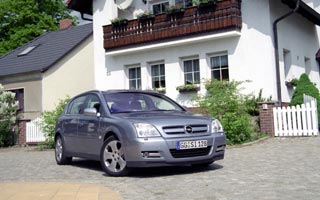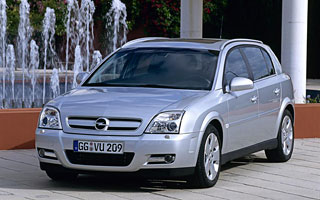West drive Opel Signum 2003 - 2005 hatchback
Geometric progression
 Few people decide to encroach on the holy - for class E, the classic sedan remains the standard. There are only two exceptions so far: Renault Vel Satis and Opel Signum.
Few people decide to encroach on the holy - for class E, the classic sedan remains the standard. There are only two exceptions so far: Renault Vel Satis and Opel Signum. Who is more tired of the usual appearance of the car - car manufacturers or buyers? The first to puzzle over how to stand out against the background of colleagues, who buy not only details, but sometimes entire units from the same suppliers. And even if different, then inscribed in obviously necessary, but monstrously narrow framework for ecology and safety standards. Consumers pretend that they do not notice this similarity, looking for millimeters of the difference in the width of the cabin and the tenth shares of liters in fuel consumption. Or they don’t look, but they buy the car that just likes. To achieve this one like this, you can hone traditional solutions, bringing them to the ideal. And you can try to experiment with what is usually not accepted for - with the image that has developed for decades.
The intersection of straight lines. The hit of recent years is a crossover, a large station wagon crossed with an SUV. There were minivans a little earlier. Although actually the story of crosses is much longer. In the mid-60s, for example, one French company released something between the station wagon and the sedan. Renault 16 became a 1966 car in Europe and remained on the conveyor for more than 15 years, and the hatchback has since appeared in the range of almost all brands, with the exception of Rolls-Royce, Lamborghini and other suppliers of objects of lust and possession, not vehicles. Should it be surprised that it was the Renault concern that ventured to take up experiments in a category that is considered a support for the classical style? Creating Vel satis (the name in Latin can be translated as enough), designers only pursued the goal of achieving the maximum effect with modern means, without looking back at the canons. The only concession to the own traditions of the brand can be considered the fifth door: the three previous generations of the top models Renault were hatchbacks.
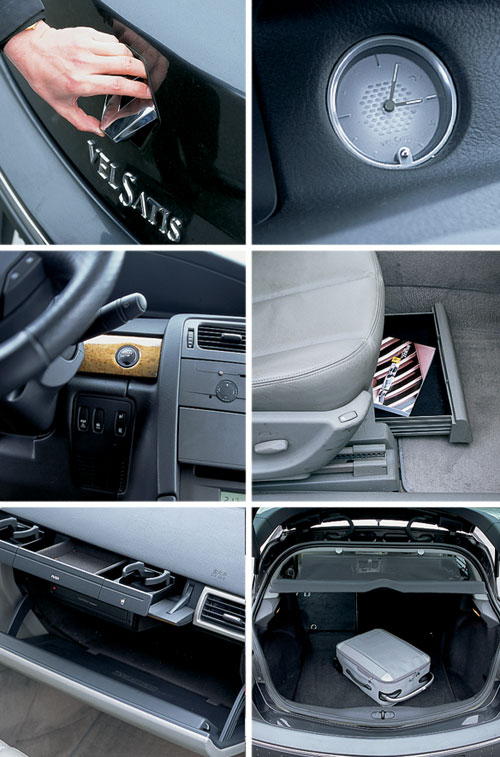
Although Signum is advertised under the motto their own class, anyone has long learned that this is the development of the Vectra line. The elongated base made it possible to establish a seat of a complex and non -trivial design from behind, so that in comfort the machine is not inferior to traditional class E models, but in functional capabilities to many minivans. The presence of a 3.2-liter V6 in the model range allows Opel to easily fit into the generally accepted class E if not by a classic silhouette, then the characteristics of the motor are accurately. To Vel satis, Opel is extremely close in almost all parameters. Since fundamentally different approaches led the developers to an almost identical result, there is clearly something in this. And soon there will be more such cars.
Parallel lines. But still the difference was discovered, and quite significant. Firstly, in price. Thanks to the dollar prices, the top version of the Opel Signum Cosmo with V6 costs less than 50 thousand dollars-with almost all available options, with the exception of the hatch in the roof. But the price of Vel Satis with a six -cylinder engine in the basic version is 48 thousand euros. At the current rate, it is already under $ 60 thousand.
True, the extra and a half thousand cu Partly compensated. And this is what. There is nothing special to complain about Signum - everything is and is conveniently located, but Vel Satis is perceived from the inside as a more stylish and, let's say, luxurious. I don’t want to offend anyone, but next to him Signum seems to be a rich merchant who was at the reception next to the aristocrat. It seems that the tailcoat is the same, and the merchant holds the fork in the right hand, but the blood affects. Here it is, a consequence of different approaches. Although, of course, the difference can be attributed to the pragmatic approach of German designers and designers. Indeed, aristocracy is wonderful, but for some reason they descended to the Opel to install the adjustable heating of the front seats, and on Renault they considered that just buttons are vibal. It is logical, but in the dark it is difficult to find.
The vector of power. The OPEL’s frontal approach is the best affects the sensations when driving. The largest engines offered by this brand once again pleased with responsiveness in the broadest sense of the word. And the pedal reacts quickly and adequately, and at the same time the motor is very condescending to the choice of transmission. Even somewhat barbaric circumvention with a manual mode does not force him to roar offended or show discontent in other ways: he just works. It seems that the engineers overdid it with five gears in this machine - such a motor would have been enough for three. If not two.
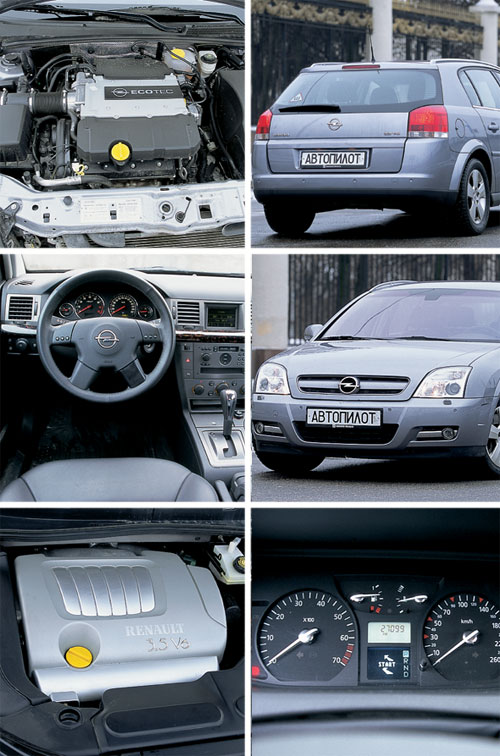
The impressions of the rest of the car units are similar. The steering wheel is somewhat harsh and, perhaps, too clearly heavy at high speeds. Which does not prevent the car from clearly obeying the driver and go exactly where it is ordered. And any curve for Signum is no worse than a straight line.
Vel satis, as befits an aristocrat, leaves a more difficult impressions. The motor is slightly larger than Opel, and, accordingly, more powerful. However, the car is also a little heavier, so the characteristics are close, as they say, to the degree of mixing. And, in general, Renault is no worse behaving on the road. Only the sensations from this are completely different. Having traveled on this car, do you remember that in French ?? Passenger car is female. Softness and sensitivity - that was the motto of those who designed and brought Vel Satis. This does not interfere with accuracy, but if Opel resembles a square, then Renault is a pattern. You know, there were once (until the AutoCAD) such templates for drawing a variety of curves. A light whisper of Nissanovsky (one of the fruits of the alliance of the French and Japanese companies) of the motor, inconspicuous overcoming of the ranges of automatic transmission, light shocks of the pendant, reminiscent that we are traveling around Moscow, and not in Paris ...
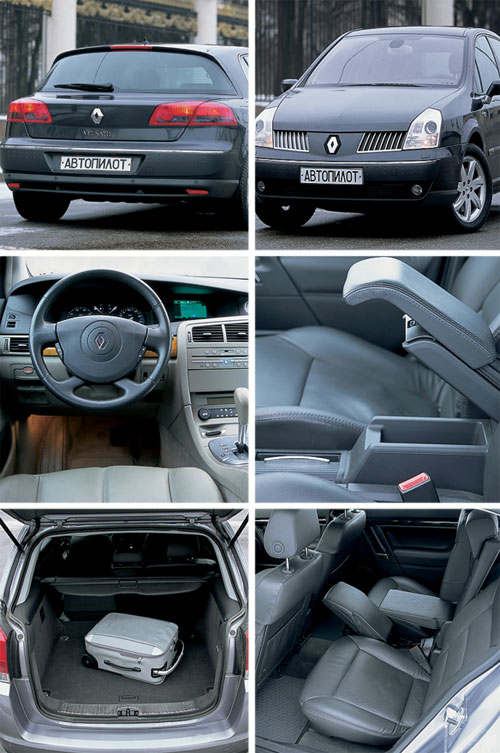
In one plane. Renault aristocracy seems unusual due to the relatively high landing characteristic of the minivans. The more practical Opel in this regard is not different from classic machines - here it remains a copy of Vectra. And, I must say, this is rather a compliment than a reproach. For all the sophistication of the Vel Satis salon, I want to criticize some solutions. In addition to the already mentioned keys of the seats from unpleasant little things, you should pay attention to the ashtray located at the central armrest. Smoking during movement in some countries is already prohibited, but since this element is present, it would be worth thinking about the convenience of its use. I didn’t really like the trunk: a light slope of the floor towards the door is sometimes useful, but when the same idea is picked up and the backs of the rear seats are picked up, it turns out not a very convenient platform. But the floor in front of the rear seat is almost even, which is required for a car of such a class where the owner often turns out to be from behind. Designers and designers did not neglect the ability to use the volume of salon for all kinds of pockets and niches. For example, drawers are not only under the front, but also under the rear seats. And under the elegant wooden bar, the cup holders and another box are hidden on the right side of the instrument panel.
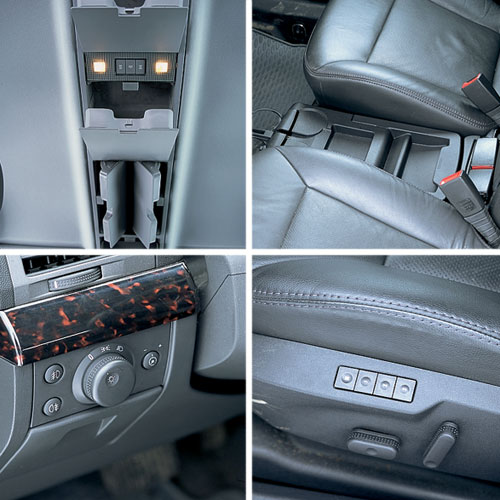
Not bad in this regard and Signum. Even a little better. The rear seats have separate adjustment both in the longitudinal direction and in the corner of the back of the back. The central segment can be turned from a not too comfortable place for the third passenger into a practical block with cup holders and a place for trifles. Just like in Rolls-Royce, the number of options of which includes something like this: a box for accommodation of written accessories. Creatively approached the ceiling: there was a place for several folding containers for glasses and other things. Renault has only one eyebrow above the driver's door.
The main question: was it worth the engineers of Opel and Renault so strain? It seems that yes - both models really offer advanced capabilities compared to classmates of the traditional design. It is necessary to pay for this, in particular, the fact that Vel Satis is confused with Megane II and wonder, looking closer to the luxury of the cabin and reading the price tag. And the possibilities of Opelsky V6 drivers of prestigious Mercedes-Benz E200 or Audi A6 have to demonstrate in action: when you see a ringed lightning on the radiator in the rear view mirror, for some reason they do not believe that this machine can overtake them.
Text Valery Chusov, photo Alexey Ilyin
Opel Signum Cosmo and Renault Vel Satis Privilege
Gasoline engine, V6 gasoline, V6
Working volume (cubic meter) 3175 3498
Power (L.S. at rpm) 211 at 6200 241 at 6000
Moment (Nm at rpm) 300 at 4000 330 at 3600
Front front drive
Gearbox 5-speed automatic
Length/width/height (mm) 4636/1798/1466 4860/1860/1577
Wheel base (mm) 2830 2840
Asselled mass/full (kg) 1613/2150 1720/2270
Maximum speed (km/h) 235 235
Acceleration to 100 km/h (c) 8.5 8.3
Fuel consumption (city/highway, l/100 km) 15.7/7.8 16.8/8.5
The price in Moscow is $ 43.9 thousand $ 61.7 thousand.
Source: "Autopilot"
Opel Signum 2003 test drives - 2005
Crash Test Opel Signum 2003 - 2005
Krassh Test: Detailed Information29%
Driver and passengers
1%
Pedestrians

